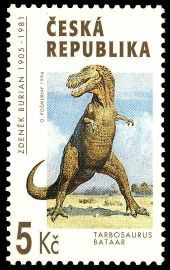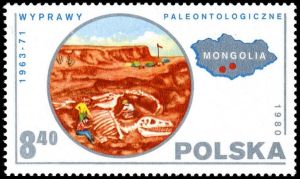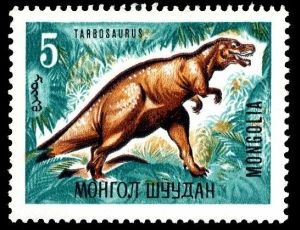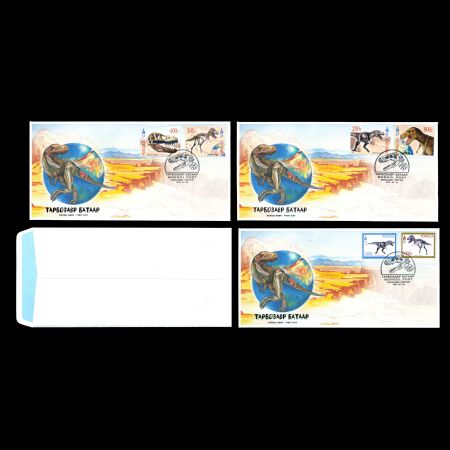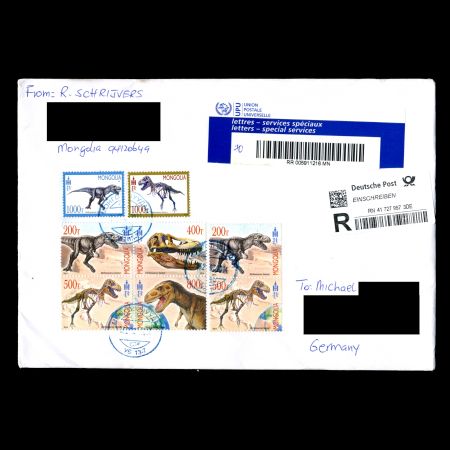| Issue Date | 24.07.2014 |
| ID | Michel: Stanley Gibbons: UPU: Category: pR |
| Author | Artist Ch.Bat-Erdene, stamp designer J.Gankhuyag |
| Stamps in set | 6 |
| Value | 200, 400, 500, 800, 1000 x2 - fossils and reconstructions of Tarbosaur bataar |
| Size (width x height) | 25.5mm х 34mm |
| Layout | two sheets of 20 stamps each, block of 4 stamps |
| Products | FDC x 3 |
| Paper | |
| Perforation | 12x12 |
| Print Technique | offset lithography |
| Printed by | Beijing Stamp Printing House of State Postal Bureau, China |
| Quantity | stamps: 25.000, FDC x100 |
| Issuing Authority | Postage Stamp Authority of Mongol Post |
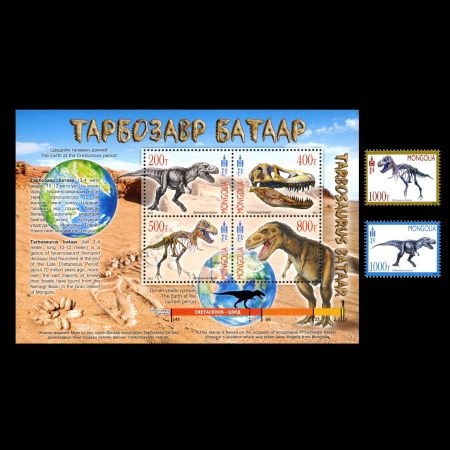
The Ministry of Culture, Sport and Tourism of Mongolia together with the "Mongol Post" (Mongol Shuudan) had jointly released the postal stamp Tarbosaurus Bataar". Both organizations officially introduced the new postal product to the Central Dinosaur Museum (CDM) on Thursday, July 24th, 2014. The stamps are 25.5 х 34 mm and come in a range of values from 200 MNT to 1,000 MNT, printed as a block of 4 stamps and two sheets, 20 stamps each and shows both fossil and reconstruction of the dinosaur. The set is dedicated to 70-million-year-old Tyrannosaurus bataar.
Tarbosaurus
is a genus of tyrannosaurid theropod dinosaur that flourished in Asia
about 70 million years ago, at the end of the Late Cretaceous Period.
Fossils have been recovered in Mongolia, with more fragmentary remains
found further afield in parts of China.
Although many species have been named, modern paleontologists recognize only one, T. bataar, as valid. Tarbosaurus and Tyrannosaurus, if not synonymous, are considered to be at least closely related genera. Like most known tyrannosaurids, Tarbosaurus was a large bipedal predator, weighing up to six tonnes and equipped with about sixty large teeth. It had a unique locking mechanism in its lower jaw and the smallest forelimbs relative to body size of all tyrannosaurids, renowned for their disproportionately tiny, two-fingered forelimbs. It was an apex predator, preying on other dinosaurs.
In 1946, a joint Soviet-Mongolian expedition to the Gobi Desert in the Mongolian Ömnögovi Province turned up a large theropod skull and some vertebrae in the Nemegt Formation. In 1955, Evgeny Maleev, a Soviet paleontologist, made this specimen of a new species, which he called Tyrannosaurus bataar. The specific name is a misspelling of the Mongolian баатар/baatar ("hero")
Although many species have been named, modern paleontologists recognize only one, T. bataar, as valid. Tarbosaurus and Tyrannosaurus, if not synonymous, are considered to be at least closely related genera. Like most known tyrannosaurids, Tarbosaurus was a large bipedal predator, weighing up to six tonnes and equipped with about sixty large teeth. It had a unique locking mechanism in its lower jaw and the smallest forelimbs relative to body size of all tyrannosaurids, renowned for their disproportionately tiny, two-fingered forelimbs. It was an apex predator, preying on other dinosaurs.
In 1946, a joint Soviet-Mongolian expedition to the Gobi Desert in the Mongolian Ömnögovi Province turned up a large theropod skull and some vertebrae in the Nemegt Formation. In 1955, Evgeny Maleev, a Soviet paleontologist, made this specimen of a new species, which he called Tyrannosaurus bataar. The specific name is a misspelling of the Mongolian баатар/baatar ("hero")
Nearly complete Tyrannosaurus bataar skeleton was returned to Mongolia following the high-profile prosecution of a Florida paleontologist by federal authorities in New York after it was sold at a Manhattan auction for $1.05 million.
During the ceremony of introduction on new postal stamp "Tarbosaurus Bataar", the Minister of Culture, Sport and Tourism Ts.Oyungerel noted
"After the rare findings of the Tarbosaurus Bataar skeleton, the noticeable sculpture artworks and fine-art paintings have been delivered; and this time, the new postal stamp was also released with great efforts from the "Mongol Shuudan". This remarkable event will surely contribute to protect our cultural heritages as well as to provide value-added cultural and economic impact to Mongolia.... The launch of these new postmarks celebrates both the 90th anniversary of Mongolia’s postmark production and modern museum establishment in Mongolia. It is delightful to see Bataar becoming the theme of postmarks.”
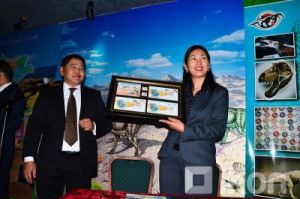 |
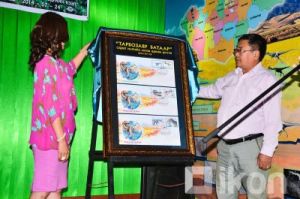 |
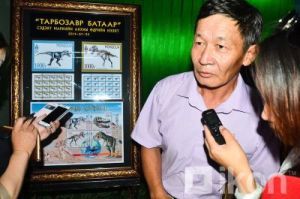 |
| Images are from Ikon.mn (Mongolian News) website | ||
Ch.Bat-Erdene talked about how he created Bataar, “Postmark depictions require more intricate drawings compared to other pieces for publications. I spent two months drawing Bataar for the postmarks. Each depiction to be used for postmarks is always based on detailed research before going to design, as they represent Mongolia’s name in the international postage market.”
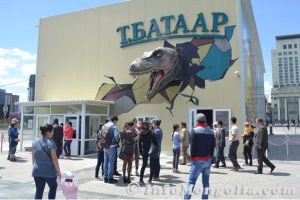
|
 |
Thestory of Tarbosaur bataar
A nearly complete skeleton of a towering Tyrannosaurus bataar is set to go on Texas-based Heritage Auction on Sunday , May 20, 2012.
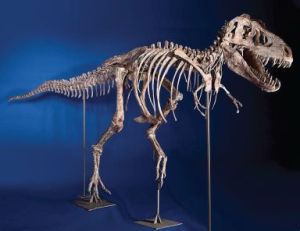 The image is from Wikipedia
|
| Tarbosaurus bataar on stamp of Czech Republic, 1994. Based on illustration of famous Czech Paleoartist Zedek Burian. |
There was no reasonable doubt that the Tarbosaurus had been stolen. China and Mongolia strictly regulate who is allowed to launch dinosaur expeditions and collect fossils and where those specimens must be reposited. There was no legal route by which the dinosaur could have ended up in a New York City auction. Days before it was set to be sold, paleontologists and the president of Mongolia objected to the auction. Paleontologist Mark Norell of the American Museum of Natural History, who has worked extensively in Mongolia, pointed out that the dinosaur must be an illicit specimen from the Gobi Desert. According to Mongolian heritage laws, any recovered bones must ultimately rest within an approved Mongolian institution.
Heritage Auctions pooh-poohed the concerns and affirmed that the auction house trusted the dealer it was working with. Greg Rohan, president of Heritage Auctions, steadfastly defended the auction, whining that it was too close to the date of the auction to do anything about the complaints of the Mongolian government and concerned researchers. Lawyers working in concert with the Mongolian government entered the kerfuffle and demanded that the auction be halted until the provenance of the skeleton could be settled. The auction went ahead as scheduled. In the middle of the bidding, a lawyer announced that he had on the phone a judge who had issued an order against the sale. Even this last-minute tactic didn’t stop the bidding. The final price of the Tarbosaurus was just over $1 million. Fortunately, the unknown buyer couldn’t simply walk off with the dinosaur. Investigations continued, now with the begrudging assistance of Heritage Auctions, and Norell and other paleontologists confirmed that the tyrannosaur must have been uncovered in Mongolia. More than that, what was billed as a nearly complete individual animal turned out to be made of several different dinosaurs. (Surprise, surprise, the smuggler wasn’t honest about his wares. Many dinosaurs that appear at auction houses are not as complete or well-preserved as they might appear to the untrained eye.)
| Polish-Mongolian joint expeditions to the Gobi Desert began in 1963 and continued until 1971, recovering many new fossils, including new specimens of Tarbosaurus from the Nemegt Formation , commemorated on stamp of Poland 1980 |
| First stamp of Tarbosaurus, Mongolia 1967. |
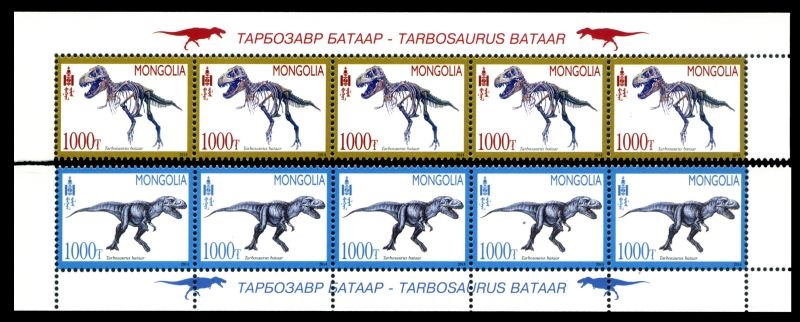 Top and bottom row of stamp sheets |
|
References: Info Mongolia Ikon.mn, UB Post Dinosaur Museum Wikipedia, Press release of Mongolian Post, The Central Dinosaur Museum, Live Science, News.mn, Slate, Nature World News
 |
|
Latest update 09.11.2017
Any feedback, comments or even complaints are welcome: [email protected] (you can email me on ENglish, DEutsch, or RUssian)
